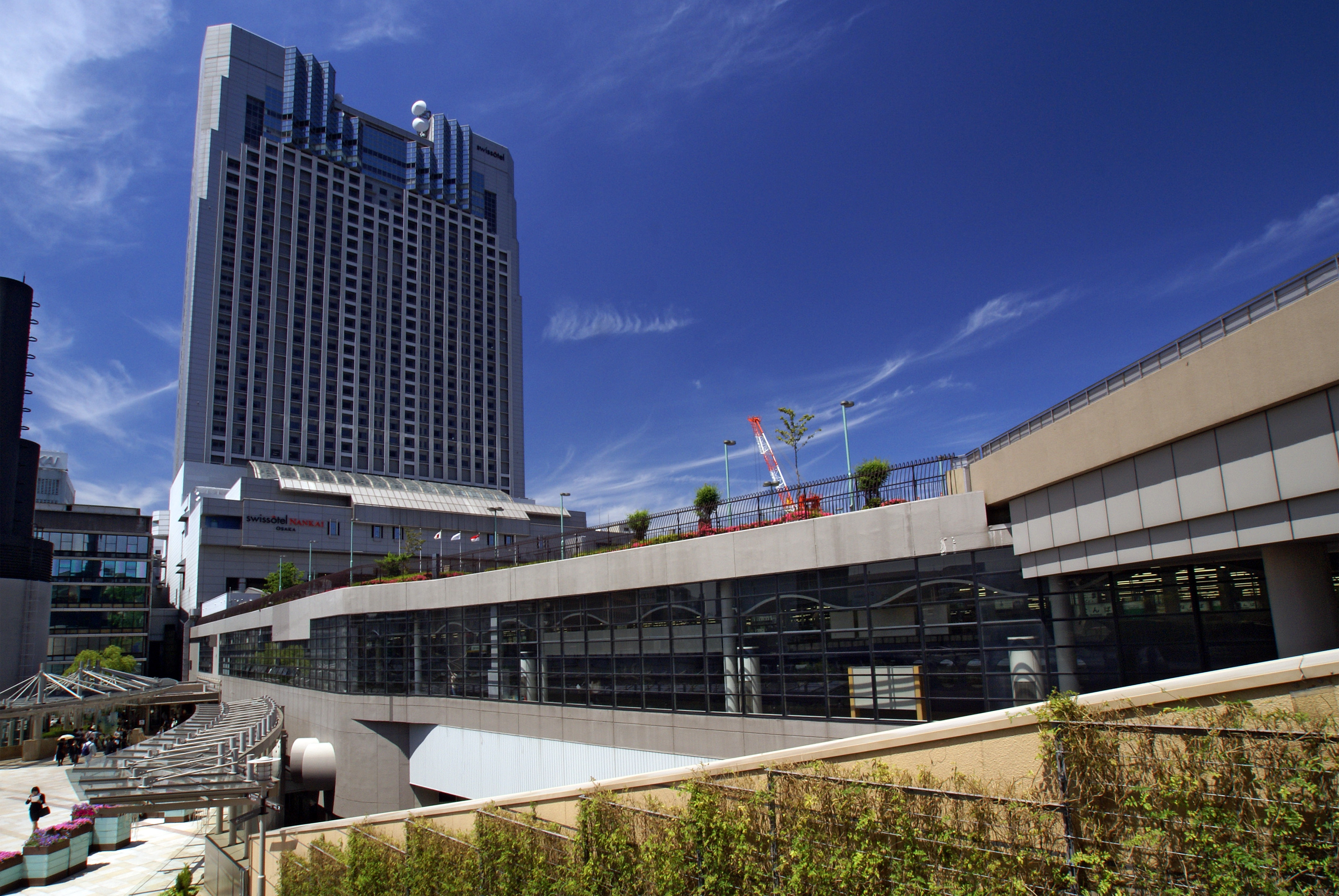|
Kongō Station
is a passenger railway station located in the city of Ōsakasayama, Osaka Prefecture, Japan, operated by the private railway operator Nankai Electric Railway. It has the station number "NK66". Lines Kongō Station is served by the Nankai Koya Line, and is 22.9 kilometers from the terminus of the line at and 22.2 kilometers from . Layout The station consists of two ground-level island platforms connected by an elevated station building. Platforms File:Kongo Station 2.jpg, West exit File:Kongo Station 4.jpg, Ticket gates File:Kongo Station 3.jpg, Platform Adjacent stations History Kongō Station opened on April 19, 1937. Passenger statistics In fiscal 2019, the station was used by an average of 32,893 passengers daily. Surrounding area * Kongō New Town * Aeon Kongo store * Osaka Prefectural Sayama High School See also * List of railway stations in Japan The links below contain all of the 8579 railway stations in Japan. External links {{Portal bar, Jap ... [...More Info...] [...Related Items...] OR: [Wikipedia] [Google] [Baidu] |
Nankai Electric Railway
is a private railway in Japan, founded in 1884. The name ''Nankai'' (which means "South Sea") comes from the company's routes along the Nankaidō, the old highway that ran south from the old capital, Kyoto, along the sea coast. Nankai predates all the electric railways in the Tokyo region. The Nankai network branches out in a generally southern direction from Namba Station in Osaka. The Nankai Main Line connects Osaka to Wakayama, with an important spur branching to Kansai International Airport. The '' rapi:t α'' express connects Kansai International Airport to Namba in 34 minutes, while the '' rapi:t β'' takes 39 minutes with two additional stops. The Koya Line connects Osaka to Mt. Koya, headquarters of the Buddhist Shingon sect and a popular pilgrimage site. IC cards (PiTaPa and ICOCA) are accepted. History The Nankai Railway Company was founded on June 16, 1884. In 1944 it was one of the companies that merged to form Kinki Nippon Railway Co., Ltd. (Kin-nichi, prese ... [...More Info...] [...Related Items...] OR: [Wikipedia] [Google] [Baidu] |
Nankai Kōya Line
The is a railway line in Osaka Prefecture and Wakayama Prefecture, Japan, owned and operated by the Nankai Electric Railway, a private railway operator. It connects Osaka and Koyasan, the capital of the Japanese Buddhist sect Shingon, via the suburbs of Osaka, such as Sakai, Osakasayama, Tondabayashi and Kawachinagano in Osaka Prefecture and Hashimoto and Kōya in Wakayama Prefecture. To distinguish it from other Nankai Lines, the Kōya Line is indicated with pictograms of coniferous-like trees which bring to mind Mount Kōya, or with the line colour, green. For historical reasons, the line formally begins at Shiomibashi Station in Osaka and crosses the Nankai Main Line, the company's other main line, at Kishinosato-Tamade Station, though operationally it starts at Namba Station together with the Nankai Line, diverges at Kishinosato-Tamade Station and goes to Gokurakubashi Station, to connect to Koyasan through Nankai Cable Line. The section from Shiomibashi to Kishinosato ... [...More Info...] [...Related Items...] OR: [Wikipedia] [Google] [Baidu] |
Railway Station
Rail transport (also known as train transport) is a means of transport that transfers passengers and goods on wheeled vehicles running on rails, which are incorporated in tracks. In contrast to road transport, where the vehicles run on a prepared flat surface, rail vehicles (rolling stock) are directionally guided by the tracks on which they run. Tracks usually consist of steel rails, installed on sleepers (ties) set in ballast, on which the rolling stock, usually fitted with metal wheels, moves. Other variations are also possible, such as "slab track", in which the rails are fastened to a concrete foundation resting on a prepared subsurface. Rolling stock in a rail transport system generally encounters lower frictional resistance than rubber-tyred road vehicles, so passenger and freight cars (carriages and wagons) can be coupled into longer trains. The operation is carried out by a railway company, providing transport between train stations or freight customer facilit ... [...More Info...] [...Related Items...] OR: [Wikipedia] [Google] [Baidu] |
Ōsakasayama
260px, Sayama Pond is a city in Osaka Prefecture, Japan. , the city had an estimated population of 158,465 in 26128 households and a population density of 4900 persons per km². The total area of the city is . Geography Ōsakasayama is located in the southeastern part of Osaka Prefecture. Sayama pond, which is said to be the oldest dam-type reservoir in Japan, is located in the center of the city and is a symbol of the city. Neighboring municipalities Osaka Prefecture *Sakai *Tondabayashi *Kawachinagano Climate Ōsakasayama has a Humid subtropical climate (Köppen ''Cfa'') characterized by warm summers and cool winters with light to no snowfall. The average annual temperature in Ōsakasayama is 14.6 °C. The average annual rainfall is 1475 mm with September as the wettest month. The temperatures are highest on average in August, at around 26.6 °C, and lowest in January, at around 3.2 °C. Demographics Per Japanese census data, the population of Ōsakasa ... [...More Info...] [...Related Items...] OR: [Wikipedia] [Google] [Baidu] |
Osaka Prefecture
is a Prefectures of Japan, prefecture of Japan located in the Kansai region of Honshu. Osaka Prefecture has a population of 8,778,035 () and has a geographic area of . Osaka Prefecture borders Hyōgo Prefecture to the northwest, Kyoto Prefecture to the north, Nara Prefecture to the southeast, and Wakayama Prefecture to the south. Osaka is the capital and largest city of Osaka Prefecture, and the List of cities in Japan, third-largest city in Japan, with other major cities including Sakai, Higashiōsaka, and Hirakata. Osaka Prefecture is the third-most-populous prefecture, but by geographic area the second-smallest; at it is the second-most densely populated, below only Tokyo. Osaka Prefecture is one of Japan's two "Fu (country subdivision), urban prefectures" using the designation ''fu'' (府) rather than the standard ''Prefectures of Japan#Types of prefecture, ken'' for prefectures, along with Kyoto Prefecture. Osaka Prefecture forms the center of the Keihanshin metropolitan ar ... [...More Info...] [...Related Items...] OR: [Wikipedia] [Google] [Baidu] |
Nankai Koya Line
The is a railway line in Osaka Prefecture and Wakayama Prefecture, Japan, owned and operated by the Nankai Electric Railway, a private railway operator. It connects Osaka and Koyasan, the capital of the Japanese Buddhist sect Shingon, via the suburbs of Osaka, such as Sakai, Osakasayama, Tondabayashi and Kawachinagano in Osaka Prefecture and Hashimoto and Kōya in Wakayama Prefecture. To distinguish it from other Nankai Lines, the Kōya Line is indicated with pictograms of coniferous-like trees which bring to mind Mount Kōya, or with the line colour, green. For historical reasons, the line formally begins at Shiomibashi Station in Osaka and crosses the Nankai Main Line, the company's other main line, at Kishinosato-Tamade Station, though operationally it starts at Namba Station together with the Nankai Line, diverges at Kishinosato-Tamade Station and goes to Gokurakubashi Station, to connect to Koyasan through Nankai Cable Line. The section from Shiomibashi to Kishinosato- ... [...More Info...] [...Related Items...] OR: [Wikipedia] [Google] [Baidu] |
Terminal Station
A train station, railway station, railroad station or depot is a railway facility where trains stop to load or unload passengers, freight or both. It generally consists of at least one platform, one track and a station building providing such ancillary services as ticket sales, waiting rooms and baggage/freight service. If a station is on a single-track line, it often has a passing loop to facilitate traffic movements. Places at which passengers only occasionally board or leave a train, sometimes consisting of a short platform and a waiting shed but sometimes indicated by no more than a sign, are variously referred to as "stops", "flag stops", " halts", or "provisional stopping places". The stations themselves may be at ground level, underground or elevated. Connections may be available to intersecting rail lines or other transport modes such as buses, trams or other rapid transit systems. Terminology In British English, traditional terminology favours ''railway station'' ... [...More Info...] [...Related Items...] OR: [Wikipedia] [Google] [Baidu] |
Island Platform
An island platform (also center platform, centre platform) is a station layout arrangement where a single platform is positioned between two tracks within a railway station, tram stop or transitway interchange. Island platforms are popular on twin-track routes due to pragmatic and cost reasons. They are also useful within larger stations where local and express services for the same direction of travel can be provided from opposite sides of the same platform thereby simplifying transfers between the two tracks. An alternative arrangement is to position side platforms on either side of the tracks. The historical use of island platforms depends greatly upon the location. In the United Kingdom the use of island platforms is relatively common when the railway line is in a cutting or raised on an embankment, as this makes it easier to provide access to the platform without walking across the tracks. Advantages and tradeoffs Island platforms are necessary for any station with many th ... [...More Info...] [...Related Items...] OR: [Wikipedia] [Google] [Baidu] |
List Of Railway Stations In Japan ...
The links below contain all of the 8579 railway stations in Japan. External links {{Portal bar, Japan, Trains * Railway stations Japan Japan ( ja, 日本, or , and formally , ''Nihonkoku'') is an island country in East Asia. It is situated in the northwest Pacific Ocean, and is bordered on the west by the Sea of Japan, while extending from the Sea of Okhotsk in the north ... [...More Info...] [...Related Items...] OR: [Wikipedia] [Google] [Baidu] |
Railway Stations In Japan Opened In 1937
Rail transport (also known as train transport) is a means of transport that transfers passengers and goods on wheeled vehicles running on rails, which are incorporated in Track (rail transport), tracks. In contrast to road transport, where the vehicles run on a prepared flat surface, rail vehicles (rolling stock) are directionally guided by the tracks on which they run. Tracks usually consist of steel rails, installed on Railroad tie, sleepers (ties) set in track ballast, ballast, on which the rolling stock, usually fitted with metal wheels, moves. Other variations are also possible, such as "slab track", in which the rails are fastened to a concrete foundation resting on a prepared subsurface. Rolling stock in a rail transport system generally encounters lower friction, frictional resistance than rubber-tyred road vehicles, so passenger and freight cars (carriages and wagons) can be coupled into longer trains. The rail transport operations, operation is carried out by a ... [...More Info...] [...Related Items...] OR: [Wikipedia] [Google] [Baidu] |
Railway Stations In Osaka Prefecture
Rail transport (also known as train transport) is a means of transport that transfers passengers and goods on wheeled vehicles running on rails, which are incorporated in tracks. In contrast to road transport, where the vehicles run on a prepared flat surface, rail vehicles (rolling stock) are directionally guided by the tracks on which they run. Tracks usually consist of steel rails, installed on sleepers (ties) set in ballast, on which the rolling stock, usually fitted with metal wheels, moves. Other variations are also possible, such as "slab track", in which the rails are fastened to a concrete foundation resting on a prepared subsurface. Rolling stock in a rail transport system generally encounters lower frictional resistance than rubber-tyred road vehicles, so passenger and freight cars (carriages and wagons) can be coupled into longer trains. The operation is carried out by a railway company, providing transport between train stations or freight customer facilit ... [...More Info...] [...Related Items...] OR: [Wikipedia] [Google] [Baidu] |



.jpg)


